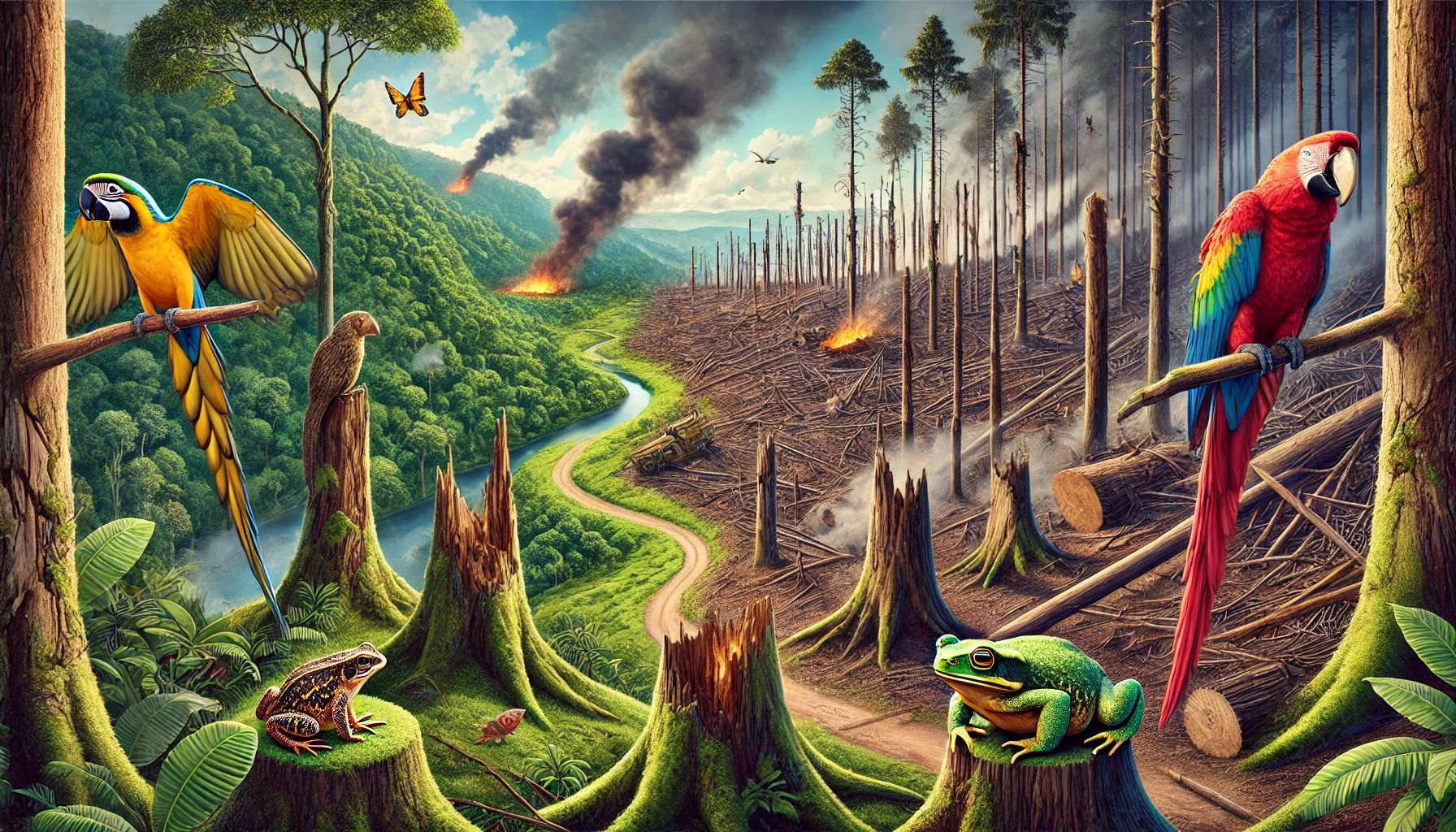Deforestation in tropical regions has led to the loss of many unique animal species. Species such as the St. Helena Redwood and the Philippine eagle have vanished due to habitat destruction, highlighting the urgent need for conservation efforts. The impact of these losses extends beyond the animals themselves, as it affects entire ecosystems and the balance of nature.
As forests are cleared for agriculture and development, the delicate habitats that many animals depend on are destroyed. The decline of these species serves as a reminder of the fragility of biodiversity in tropical areas. Exploring the stories behind these extinct animals can help raise awareness about the importance of preserving what remains.
Understanding what animals have been lost can inspire action to protect current wildlife. By learning about the past, it becomes possible to foster a brighter future for the creatures still facing threats from human activities.
Impact of Deforestation on Tropical Wildlife
Deforestation has a severe impact on tropical wildlife, affecting their habitats and survival. As trees disappear, the natural environments for many species are disrupted, leading to significant challenges for their existence and well-being.
Habitat Loss and Fragmentation
Habitat loss occurs when forests are cleared for agriculture, urban development, or logging. This leads to the destruction of homes for many animals. For instance, species like orangutans depend on extensive forest areas for food and shelter.
Fragmentation happens when large habitats are broken into smaller patches. This can isolate animal populations, making it harder for them to find mates or food. Creatures like the jaguar may struggle when their territories are split. As a result, animals may face increased competition and mortality, further threatening their survival.
Species Vulnerability and Extinction Rates
The loss of habitat makes many species more vulnerable. Approximately 137 species of animals are lost every day due to deforestation. This includes gradual declines in populations of birds, mammals, and reptiles that are crucial to the ecosystem.
Some species find it difficult to adapt to new environments, making them prime candidates for extinction. For example, the Spix’s macaw became extinct in the wild, mainly due to habitat loss. As the tropical forests shrink, the risk of extinction climbs for many other species, pushing them closer to disappearing forever.
Specific Animals Impacted by Tropical Deforestation
Tropical deforestation has led to the extinction of various animal species, showcasing the fragile balance within these ecosystems. The following examples illustrate the dramatic effects of habitat loss on specific animals historically impacted.
The Dodo: An Emblem of Extinction
The Dodo, native to the island of Mauritius, is often seen as a symbol of extinction. This flightless bird thrived in a tropical habitat rich in fruit and dense forests.
As European sailors arrived in the late 1600s, they brought invasive species such as rats and pigs. These animals consumed Dodo eggs and competed for food. Deforestation for farming also destroyed their natural habitat, leading to the Dodo’s extinction by the late 17th century.
The Passenger Pigeon: From Abundance to Extinction
The Passenger Pigeon was once the most populous bird in North America, with flocks that could darken the sky. These birds relied on vast forests for nesting and food.
However, by the late 1800s, intense hunting and habitat destruction drastically reduced their numbers. Deforestation contributed to their decline by removing their nesting areas, making it nearly impossible for the species to survive. The last known Passenger Pigeon died in captivity in 1914, highlighting the impact of human activity on their fate.
The Great Auk: A Story of Human Impact
The Great Auk, a penguin-like bird, was found along the North Atlantic coasts, including tropical regions. These birds were known for their charming appearance and flightlessness.
During the 19th century, they were hunted for their feathers, meat, and eggs. Deforestation for expanding human settlements also threatened their nesting sites. As hunting intensified, the Great Auk disappeared from its habitats. The last confirmed sighting was in the mid-1800s, marking another tragic loss due to human influence.
Conservation Efforts and Rewilding Initiatives
Efforts to protect endangered species and restore ecosystems are vital in the fight against deforestation. By implementing protected areas, boosting breeding programs, and engaging communities, significant changes can be made to help lost species return.
Protected Areas and Legal Frameworks
Creating protected areas is an essential step in conserving biodiversity. These areas are designated for the preservation of unique ecosystems and the species that inhabit them.
Legal frameworks, such as national parks and wildlife reserves, set boundaries that limit harmful activities like logging and mining. Such laws help ensure that natural habitats remain intact and provide safe spaces for wildlife.
Enforcement of these laws is critical. Without it, illegal activities could dismantle the very protections put in place.
Captive Breeding and Species Reintroduction
Captive breeding programs focus on raising endangered animals in controlled environments. These programs can help increase populations and enhance genetic diversity.
Once the animals are stable, they can be reintroduced into their natural habitats. Successful reintroduction efforts are evident in species like the California condor and the Arabian oryx.
Such initiatives often involve extensive research to understand the specific needs of each species. It is essential to ensure that the reintroduced animals can adapt to their environment.
Community Involvement and Sustainable Practices
Involving local communities is crucial for successful conservation. When people understand the importance of protecting their environment, they are more likely to participate in efforts to save endangered species.
Education programs can raise awareness about the benefits of biodiversity. Workshops often teach sustainable farming and logging practices, which help lessen the impact of deforestation.
By promoting eco-tourism, communities can develop economically while protecting their natural resources. Sustainable practices help balance human needs with the environment, fostering a healthier ecosystem for all.

